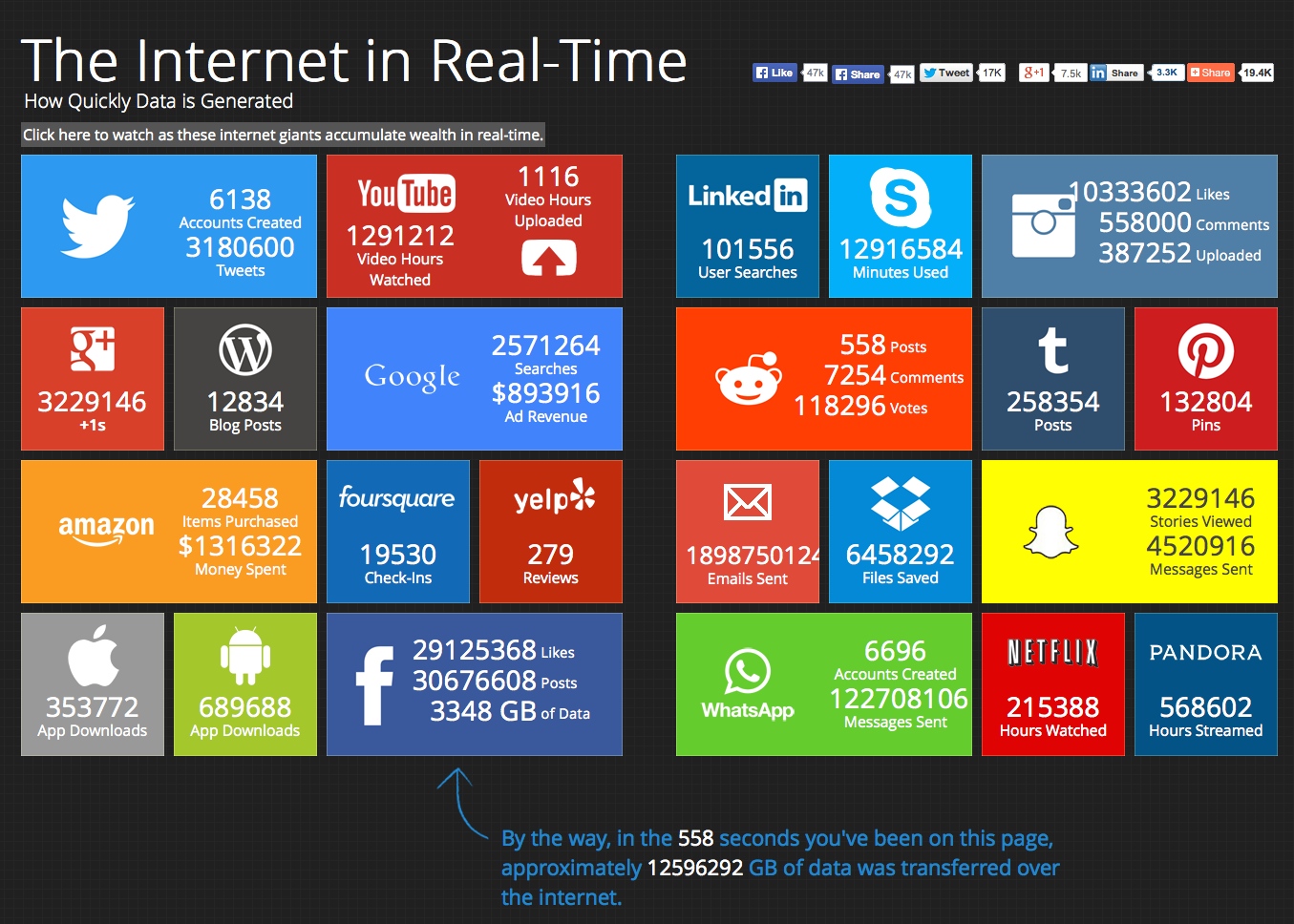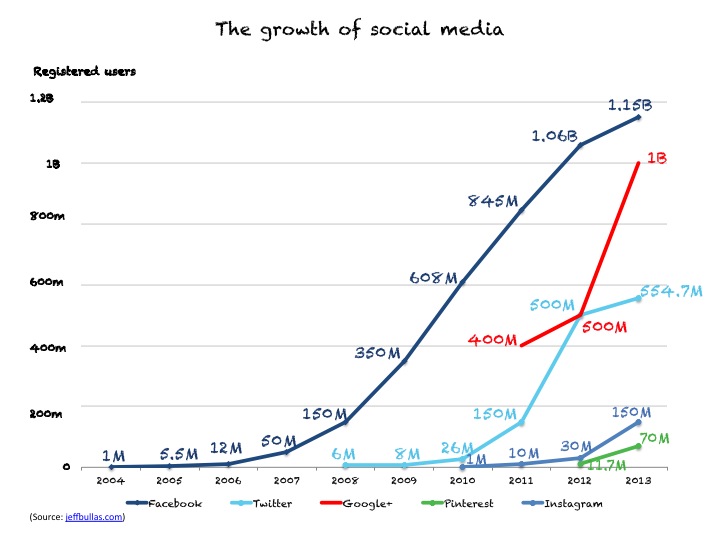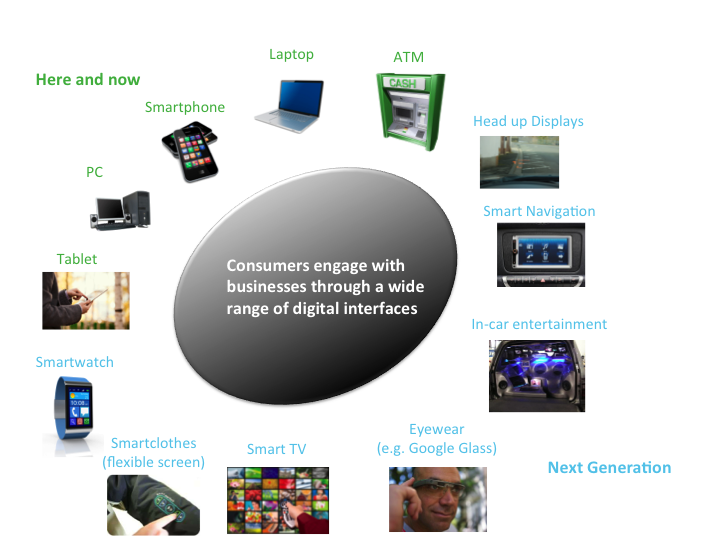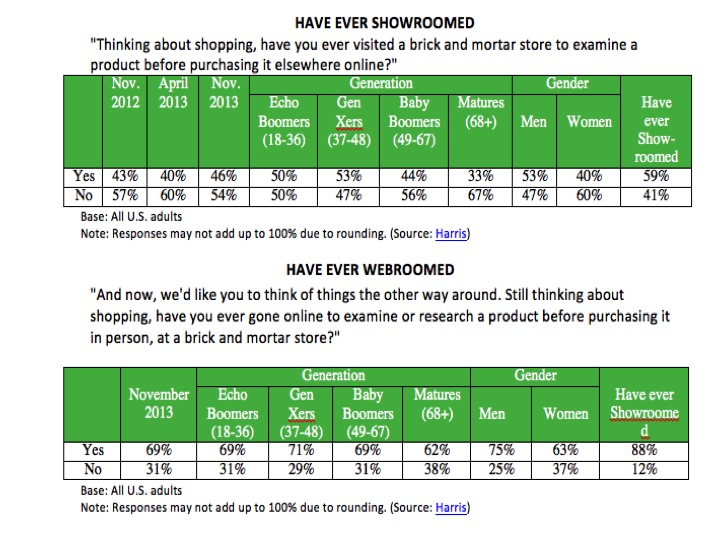July/August 2014: Consumers are living and breathing technology and there is no sign of it slowing down. Today’s world is so digitally connected and full of information that choices can sometimes be overwhelming and opaque. However, more choice, along with information means greater power and freedom to influence your life and environment. Consumers have never been savvier, more demanding, value conscious, and connected. But bear in mind that while today’s consumers are almost always connected, future consumers will most likely be always connected as technologies become wearable and even implanted in the body.
Channels to market are also undergoing fundamental shifts as technologies drive new routes to market (both physical and digital) as well as new purchase behaviors, from “view in store, buy online” to self-scan check-outs, and mobile payment systems that could replace the cash register completely. Smart devices are radically changing the purchase process, and ultimately mean fewer shoppers in store. In this environment, businesses and channel intermediaries face an increasing threat of losing direct relationships with the consumer or customer. The challenge: how to be where your customers are and deliver value that is relevant to them where and when they want it.
In this briefing we take a journey into the minds of 21st century consumers to see what is important for them, as well as to see what changes are necessary in the business environment to respond to the fundamental changes taking place in the world’s consumption behaviors. Business as usual is simply not option.
NEW: Also see our slideshow presentation of The 21st Century Consumer: What Matters?
A few facts about the connected world
Connectivity – the number of internet users globally: By the end of 2014, the number of internet users globally will reach almost 3 billion, two-thirds of them from the developing world. Globally, 4 billion people are not yet using the internet and more than 90% of them are from the developing world. 2014 internet user penetration growth rates in developed countries remain at a relatively low level at 3.3% compared with 8.7% in developing countries. Overall, internet user penetration has reached 40% globally with 78% in developed countries and 32% in developing countries. (Source: ITU) One of the results of this increasing connectivity is the massive rise in data generated as the snapshot below indicates.

(Source: Pennystocks)
Who is using what – social media in numbers:
-
- 93% of marketers use social media for business.
- 70% of brands have a presence on Google+.
- 70% of marketers have used Facebook to successfully gain new customers.
- 34% of marketers have used Twitter to successfully generate leads.
- Facebook, Twitter and Google are the top 3 social media sites used by marketers.
- Flickr, Tumblr and Stumbleupon are the least popular sites used by marketers.
 What’s happening with e/m/s-commerce? E- and M-commerce is skyrocketing while social commerceis still in its infancy. The major social networks can’t really figure out how to bring sales direct to their platforms despite the fact that in 2013 about two-thirds of social media generated e-commerce sales came from Facebook, Twitter and Pinterest. According to eMarketer B2C e-commerce sales globally will increase from US$1.058 trillion in 2012, to US$1.505 trillion in 2014, to US$2.357 trillion in 2017. Growth will come primarily from the rapidly expanding online and mobile user bases in emerging markets, increases in m-commerce sales, advancing shipping and payment options, the push into new international markets by major brands, and traditional retailers’ increased investments in online sales. The US is still the top e-commerce market but expectations are that China will overtake the US as the biggest e-commerce spender at the beginning of 2016. Rapidly growing countries including China, India, Indonesia, Argentina, Mexico, Brazil, Russia, Italy and Canada are expected to be the main driver of e-commerce growth globally in the years to come.
What’s happening with e/m/s-commerce? E- and M-commerce is skyrocketing while social commerceis still in its infancy. The major social networks can’t really figure out how to bring sales direct to their platforms despite the fact that in 2013 about two-thirds of social media generated e-commerce sales came from Facebook, Twitter and Pinterest. According to eMarketer B2C e-commerce sales globally will increase from US$1.058 trillion in 2012, to US$1.505 trillion in 2014, to US$2.357 trillion in 2017. Growth will come primarily from the rapidly expanding online and mobile user bases in emerging markets, increases in m-commerce sales, advancing shipping and payment options, the push into new international markets by major brands, and traditional retailers’ increased investments in online sales. The US is still the top e-commerce market but expectations are that China will overtake the US as the biggest e-commerce spender at the beginning of 2016. Rapidly growing countries including China, India, Indonesia, Argentina, Mexico, Brazil, Russia, Italy and Canada are expected to be the main driver of e-commerce growth globally in the years to come.
What’s on the mind of the 21st century consumer?
As our lives have become an increasing race against time, a pressure that translates into new attitudes and behaviors that favor convenience, immediate gratification, and feedback. While choices are overwhelming, connectivity drives awareness, sharing, and collaboration in a world where consumers are constantly seeking out what’s new. People are transforming from CONsumers into PROsumers. They know what they want, if they want to consume at all. Self-sufficiency via savvy making and sharing are taking over. For many, experiences are becoming more valuable than possessions – and information is king in the world of consumption. Consumer behaviour is also increasingly demonstrating a mindfulness that does not necessarily mean buying less but just more selectively.
Quality and price expectations are high, with businesses and brands struggling to keep consumer loyalty as consumers put less trust in brand messages and more trust in prices and their own personal definitions of value. Rising demands for increasing, always accessible choice and innovation are also challenging businesses and brands by shortening life-cycles for products and services. For businesses now and in the future the consumers’ willingness to pay and engage are critical areas to focus on.
What’s important for 21st century consumers?
Let’s get personal:It is still all about “Me.” Consumers love personalized and/or customized products and services. Thanks to ever-advancing technology, such products and services are increasingly affordable. We all want to be unique in our own way, whether it is our personality, style or music choice. Standard goods and services are no longer the key to attracting and retaining consumers. Nor is it only about receiving a tangible product or service. Individualism, personalized experience, and uniqueness are key factors. In an age of information overload, mass communication and advertising are tiresome; consumers demand tailored, relevant content and experiences from brands and information providers, all increasingly possible with location-based technology and online platforms. According to a global survey from PWC digital shoppers increasingly say they want personalization of promotions based on their past purchases and retailers are getting better at delivering it. PWC saw a major jump from 9% in 2012 to 21% in 2013 in participants who visited brand social media sites because of personalized promotions via email or text. (Sources: PWC, GT Trend Report: Shapers & Influencers – Consumers/Individuals)
Green and local are better: Consumers are scrutinizing ingredient lists ever more closely, seeking out organic, non-genetically modified and sustainable “farm to table” products that can be traced back to local and regional farmers and producers, according to a survey released by Market LOHAS. Third-party certifications and heightened media coverage are helping to drive interest in sustainable meat, poultry and seafood. Another survey from The Regeneration Roadmap reveals that two-thirds of consumers say that “as a society, we need to consume a lot less to improve the environment for future generations” (66%), and that they feel “a sense of responsibility to purchase products that are good for the environment and society” (65%). These findings are based on 6,224 consumers across Brazil, China, India, Germany, the United Kingdom and the United States. (Sources: Market LOHAS, The Regeneration Roadmap)
Let’s share: Why pay full price for something when you can rent it cheaper from someone online? That is what more and more people are thinking today. Some share for fun, others for economic reasons but the fact is that consumers are sharing as never before. Many are increasingly questioning the value of having possessions such as cars, bikes, books, music, and even dogs. Technologies are now available to let them share, rent, or barter for these items easily, almost anywhere, while growing urbanization means that there is a critical mass of people to participate, so ownership is simply not necessary. Nor is it desirable for many as concerns over the environment and global issues prompt a rethink of consumption itself. The question is not just do we need to own it? It is do we need it at all?
Can we trust YOU? There’s a fine line between consumers getting valuable, personalized services and the thought of being watched. Data security is a major concern for many consumers. A global study from PWC suggests that the top 3 reasons for not buying products online are: 1. I prefer to touch/try the product (54%); 2. I just prefer to shop in-store (52%); and 3. I’m worried about the security of my personal data (43%), which is slightly up from 41% in 2012. Walking the fine line between offering customized service while securing personal information will be an ongoing balancing act for businesses in the future!
Go onmichannel or get left behind – Winning the 21st century consumer
Consumers are searching, researching clicking, liking, responding, and retweeting as never before, bringing to life whatever information they want or need. The online world is in constant motion with new technologies and channels to reach the consumer, and everyone vying for attention, individuals and organizations alike. And attention must increasingly be treated as a scarce commodity. Business and brands trying to reach the consumer must bid in the “attention auction,” one where not everybody can win every time. With the generation of data and information skyrocketing, to the point of overwhelming overload, in future it will for businesses to understand what will attract the attention of consumers – and how to keep it.
The number of channels through which influence can be purveyed is exploding. Ideas, norms, rules and opinions, created by individuals and social networks as well as established shapers and influencers, can be “tweeted” around the world in no time, or visually communicated through ever-faster broadband and wireless connections. Peer and word-of-mouth influence is increasing, real-time feedback is expected, and the global brain is alive and active. Getting the consumers’ attention through one channel is no longer an option; reaching tech-savvy and on-the-go consumers through a wide range of different channels (and devices) is a must!

In Action
Who do we listen to – some mind-blowing facts: People are turning to peers and communities for direction on norms and behaviors, and for action on critical issues, accelerating a shift of power towards society. There are many reasons why brands should care about and harness the power of word-of-mouth (WOM) to improve brand perception, reputation, and customer loyalty. Below are just a few:
-
- Word-of-mouth influences 50% of purchase decisions.
- 1,000+ customers can generate up to ½ million conversations about your brand.
- 92% trust recommendations from friends and family more than any other form of advertising. Just 10% of consumers say they trust brands today – down from 17%last year.
- 89% of consumers say customer testimonials are the most effective content. 81% of consumers are influenced by friends’ social media posts and 70% of consumers view online customers reviews first when considering a brand.
For more facts check out the Word-of-mouth infographic here.
Craving the visual story: Our brains process visuals 60,000 times faster than text. About 93% of all communication is non-verbal and 92% of consumers want brands to make ads that feel like a story. It is not without reason that story-friendly platforms, e.g. Facebook, YouTube, Pinterest and Instagram, are popular. Studies show that blog posts with visuals drive up to 180% more engagement than those without because a visual image can allow people to digest your content, then decide if they want to continue to read the article. Examples of businesses that do visual storytelling well include: Red Bull, Dunkin’ Donuts via Instagram,Vine and Pinterest, Sephora via Pinterest and Facebook, Coca Cola via Pinterest. (Source: Fast Company, Social Media Examiner)
Look out for…
Bricks-and-mortar – in or out? In recent years e-commerce has become the norm and has been perceived as a serious threat to bricks-and-mortar retailers. However, the new phenomenon “reverse showrooming” or “webrooming” (where consumers do their research online and then head to the store to actually make a purchase) is making its entrance into the world of retail, helping retailers respond to the challenges of e-commerce and showrooming (the practice of comparison shopping products and price and then purchasing online) challenges. In the U.S 69% of people webroom while 46% showroom according to a Harris Poll. To be clear, these two consumer behaviors are far from mutually exclusive but do indicate that bricks and mortar can still be an attractive environment. It is, though, critical for retailers to be present in the online room. (Source: Harris)

Gen C and do not forget Gen Alpha: While for now the buying power, habits and mindsets of the under 30, social media obsessed Millennials generation will play a tremendous role for retailers in the coming decades, businesses, brands, and retailers should not forget to start thinking about the soon to come and even more digital generation Z. Constant multitasking and real-time experience is part of the generation Z lifestyle. Patience is no longer a virtue. This generation of consumers will want things now and in exactly the way they want them. Expect more frequent communications, composed of short bursts with built-in feedback loops, through multiple channels when communicating with this generation. And keep in mind that a new generation is already close behind – Generation Alpha, loosely defined as born after 2010, will be a generation that only knows a world living in real-time; it is expected to be even more materialistic and technology-focused the preceding generation Z. (Source: QSR, news.com.au)
In September: Look out for trends in action on
The Robots are coming!




